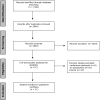Preoperative Methods to Reduce Liver Volume in Bariatric Surgery: a Systematic Review
- PMID: 26123526
- PMCID: PMC4709363
- DOI: 10.1007/s11695-015-1769-5
Preoperative Methods to Reduce Liver Volume in Bariatric Surgery: a Systematic Review
Abstract
Background: Patients qualified for gastric bypass surgery have an enlarged and fatty liver. An essential step in gastric bypass surgery is elevation of the left liver lobe to expose the gastroesophageal junction. An enlarged and fatty liver complicates the surgical procedure and increases the risk for laceration of the liver. The aim of our study was to evaluate methods to reduce liver volume in patients prior to gastric bypass surgery.
Methods: A systematic literature search of multiple databases, including PubMed, EMBASE.com, and the Cochrane Library and a hand search of reference lists, was performed. We used the search terms morbid obesity and liver, including their synonyms and controlled terms. Inclusion criteria were as follows: patients with morbid obesity who qualified for bariatric surgery, the use of a preoperative treatment to reduce liver volume, and the use of imaging techniques before and after treatment.
Results: In total, 281 patients in 11 different studies were included. Preoperative diets reduced liver size by an average of 14%, alternative methods including nutritional supplements, reduced liver size between 20 and 43%, and an intragastric balloon by 32%.
Conclusions: This review showed that nutritional supplements and intragastric balloon are more effective than low calorie diets in reducing liver volume prior to gastric bypass surgery. However, low calorie diet is the preferable method to reduce liver volume, considering the level of evidence and practical applicability. There is a need for well-designed randomized studies with sufficient power in order to confirm the effectiveness of preoperative methods to reduce liver volume.
Keywords: Bariatric surgery; Laparoscopic Roux-en-Y gastric bypass; Liver; Liver volume; Preoperative care; Preoperative diets.
References
Publication types
MeSH terms
LinkOut - more resources
Full Text Sources
Other Literature Sources
Medical
Research Materials


